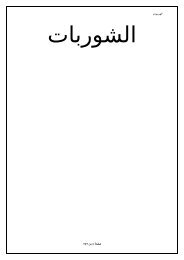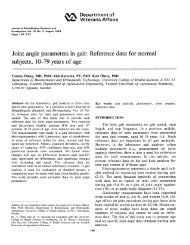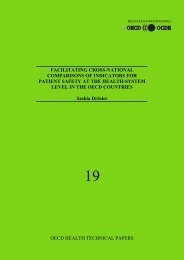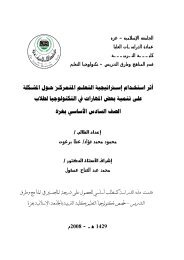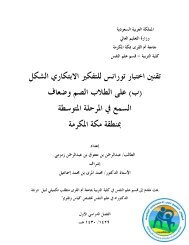PHYSIOTHERAPY BASED ON THE BOBATH CONCEPT FOR ...
PHYSIOTHERAPY BASED ON THE BOBATH CONCEPT FOR ...
PHYSIOTHERAPY BASED ON THE BOBATH CONCEPT FOR ...
You also want an ePaper? Increase the reach of your titles
YUMPU automatically turns print PDFs into web optimized ePapers that Google loves.
ACCREDITING AGENCIES <strong>FOR</strong>RESPIRATORY CAREATIVY TECH COMMUNITY COLLEGEThe Respiratory Care Program, of Ivy Tech Community College – Wabash ValleyRegion is accredited by theCommission on Accreditation for Respiratory Care.Commission on Accreditation for Respiratory Care1248 Harwood RoadBedford, TX 76021-4244http://www.coarc.com(817) 283-2835 (817) 354-8519 (fax)The Higher Learning Commission of the North Central Association of Colleges andSchools30 North LaSalle Street, Suite 2400Chicago, Illinois 60602-2504http://www.ncahlc.orgPhone: 800-621-7440 / 312-263-0456Fax: 312-263-7462Page4
6 M. Pacireference to age, sensory, cognitive or communicative problemsand so on. For example, in the opinion of many Bobaththerapists NDT should be applied preferably to people aged55–75 years and it is difficult to justify pure Bobath for peopleover 80 years of age (25). No data from this review support thishypothesis. The limit between acute and chronic hemiplegia wasfixed within 6 months, because during this period effects ofspontaneous recovery cannot be excluded (26). Controlled trialsshould include either acute or chronic patients, becausespontaneous recovery could bias results. In this review 1 RCT(16) and 2 CT (10, 13) do not report when rehabilitation startedand 3 CT include chronic and acute patients together(19, 22, 23). On the other hand, non-controlled trials shouldinclude only chronic subjects, otherwise effects of spontaneousrecovery is not excluded. Two case series assess acute subjects(17, 21) and the third includes acute and chronic patientstogether (18).Also treatments and outcome measures present little homogeneity.In fact, controlled trials were performed using 9different types of intervention, duration of rehabilitation andoutcome measures have a variability that makes results difficultto compare. The most frequently used outcome measures werefunctional scales or tests. Functional measurements alone are notsuitable to assess Bobath treatment effects, because they are ableto show only improvement of functional ability, but not thatmotor recovery has occurred on the affected side, as searched byphysiotherapists using NDT. All trials on gait re-education usegait analysis, but different aspects were assessed.An important aspect of the Bobath concept is the treatment oftone anomalies. Two studies (11, 19) consider this, but they donot support Bobath’s claim that the techniques exert a specialinfluence on muscle tone and the superiority of the Bobathapproach in decreasing muscle tone when compared with otherapproaches. This is supported by other researchers. Dickstein &Pillar (27) examine the effects of reflex-inhibiting patterns usingelectromyographic feedback and no effects on reduction ofmuscle tone were found. Hesse et al. (28) found an increasingtrend of extensor spasticity of the plantar flexor during gait withtherapeutic facilitation according to the NDT technique comparedwith walking with and without a cane. On the contraryrecent studies (29) show how sustained muscle stretch is able toreduce enhanced motoneuronal excitability. At present Bobathphysiotherapists do not use reflex inhibiting patterns but they tryto control muscle tone during functional performances. Muscletone measurement is considered not very accurate. For example,the Ashworth Spasticity Scale (original and modified form) is acommonly used scale to assess muscle spasticity, but itsreliability and construct validity is questioned by several studies(30).Only 4 authors (12, 15, 21, 22) described in detail the contentsof treatment sessions or use standardized protocols. Differenttypes of treatment could have been used by the other authors,because physiotherapy depends upon the expertise of thephysiotherapists, their understanding of the implications of thetheory on which the Bobath approach is based and uponthe current framework of the approach at the moment of thestudy.Follow-up is present in few studies (14, 22, 24) and only oneexplains treatment during the period between the experimentaltreatment and the follow-up (no treatment) (22).Trials on upper limb rehabilitation are well-designed studies,all of them are single-blinded RCTs; trials on general treatmentare controlled trials, but one is a double-blind RCT (15),remaining investigations are controlled trials classified at levels3 (10, 11, 13) and 4 (12). Trials on lower limb or gait reeducationare classified at levels 2 (16), 4 (19, 20) and 5(17, 18, 21).RCTs are recognized as the best method of comparing theeffectiveness of different treatments but controlled studiesincluded in this review investigate relative effectiveness ofNDT. On the other hand, Morley (31) judged single case series asuitable way to investigate effectiveness of an intervention,because of subjects variability, but the evidence from single casestudies is weak. So, none of the selected studies analyse realeffectiveness of the Bobath concept. A suitable method toexamine effectiveness of an approach such as NDT should be aRCT comparing a non-specific physiotherapy group with anexperimental group treated with the same non-specific physiotherapyplus specific aspects of NDT (e.g. gait re-education)equally intensive and frequent. Subjects should be included inhomogenous groups for age, cerebral damage characteristics,associated problems, start of rehabilitation and so on. Importantproblems concern outcome measures. One of the most importantgoals of Bobath therapists is to obtain normal movementpatterns in their patients (32). The quality of movement is animportant aspect of the quality of life, but, at the moment, itsmeasure is difficult to standardize. So, the real benefits of theBobath approach may have been underestimated because of thefunctional outcome measures used in the trials selected for thisreview. In fact, changes in movement can be achieved followingrehabilitation (21) and specific manoeuvres (28) based on theBobath concept. Particular aspects of movement analysis, suchas shown by Lennon (21) and Hesse et al. (28), seem to be apromising way to analyse patterns of movement.Few studies (13–15) report data on cost-benefit of use of NDTfor adult patients and 2 of them report a longer hospitalizationfor NDT groups. Moreover, Lord & Hall (33) also found, in aretrospective study comparing traditional functional retrainingwith neuromuscular functional retraining, an eclectic approachincluding NDT, a significantly longer rehabilitation hospitalization(p = 0.001) for neuromuscular functional retraining group,with no difference between groups in terms of skill levels. Thisis an important aspect of effectiveness evaluation, which shouldbe considered when rehabilitation programs are assessed orapplied (6, 25).LimitationsSome trials could not be included in this review because severalauthors, particularly regarding control groups, report conventionaltreatment without explaining what type of procedures theyJ Rehabil Med 35


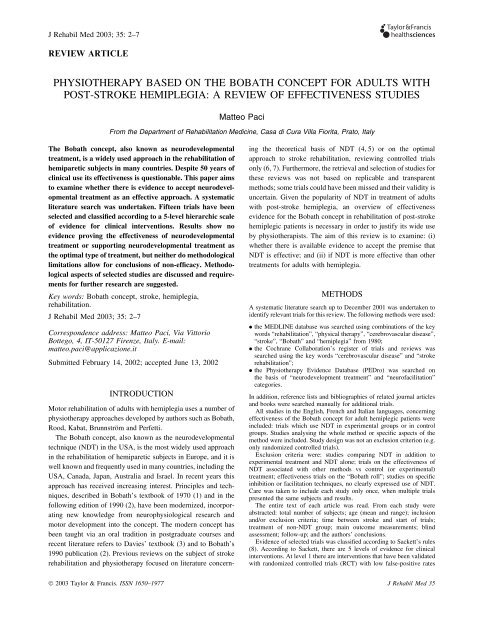

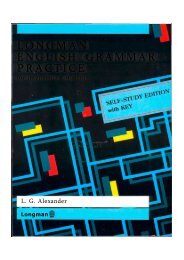

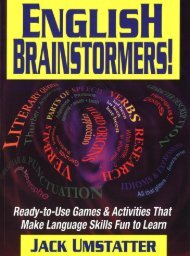
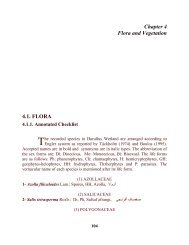
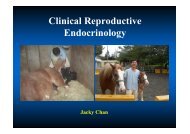
![Successful Ministry to the Retarded[ETowns] - Elmer Towns](https://img.yumpu.com/47721906/1/190x252/successful-ministry-to-the-retardedetowns-elmer-towns.jpg?quality=85)
